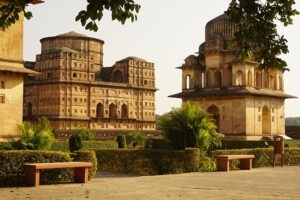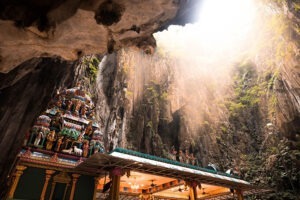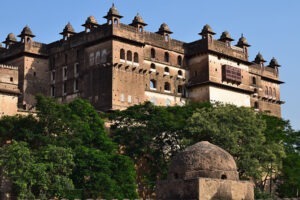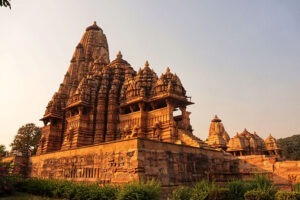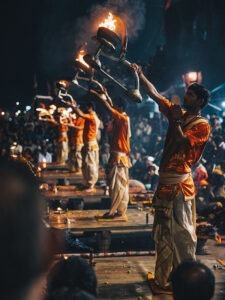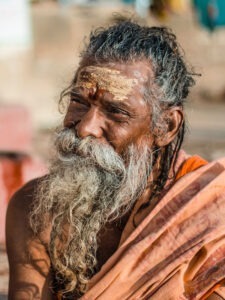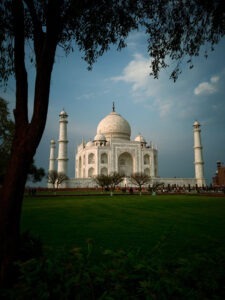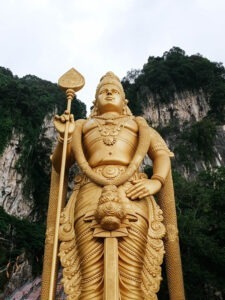Are you a history fan and want to discover the most beautiful temples of Central India? Let Mannat Travel arrange it and come and discover the gems of Central India.
1/ Elephanta Caves
On an island in the Arabian Sea off the coast of Bombay, the “City of Caves” is a typical cave complex of the Shiva cult where the art of India has found one of its most perfect expressions, especially in the gigantic high reliefs of the main cave.
2/ Ellora and Ajanta Caves
Ellora: thirty-four monasteries and temples have been carved in close succession into the face of a high basalt cliff not far from Aurangabad, helping to bring to life a brilliant ancient civilization in an unbroken sequence of monuments dating from 600 to 1000. The Ellora complex is a unique artistic achievement and a technical tour de force. With its shrines dedicated to Buddhism, Brahmanism and Jainism respectively, it illustrates the spirit of tolerance characteristic of ancient India.
Ajanta: A group of Buddhist cave monuments from the 2nd and 1st centuries BC were joined in the Gupta period (5th and 6th centuries) by even larger and richer cave paintings. The paintings and sculptures of Ajanta are masterpieces of Buddhist religious art that have exerted considerable influence.
3/ The ghost town of Mandu in Madya Pradesh
Mandu in Madhya Pradesh is a ruined ghost town in the Malwa region of Dhar district. Today, the place is one of the major tourist attractions of the state and has a number of Jain temples, mosques and old buildings. Located at a distance of about 100 km from Indore, Mandu is situated on a hill and is among the most visited ghost towns in India. The place attracts visitors from all over the country, as a number of ancient stories are associated with it. The most famous are those of Rani Roopmati and Sultan Baz Bahadur, which add to the romantic feel of this ghost town.
4/ Meheshwar and Omkareshwar
The word Maheshwar in Hindi means Great God, a nickname of Lord Shiva. Maheshwar is located on the banks of the river Narmada in the Khargone district of Madhya Pradesh. Maheshwar was a glorious city at the dawn of Indian civilization. This temple town has a treasure of magnificent temples that soothe the soul. It is also mentioned in the epics of Ramayana and Mahabharata.
A center of handloom since the 5th century, Maheshwar produces exquisite sarees and Maheshwari fabrics. The city was also the capital of the Rajmata Ahilya Devi Holkar empire in the 18th century. The life-size statue of Rani Ahilya Bhai sitting on the throne can be seen at the AhilyaBai Fort and Palace.
According to Hindu legend, Vindhya, the deity of the Vindhya mountain range, worshiped Lord Shiva to make amends for sins committed. Thus, he created a sacred geometrical pattern and a lingam made of sand and clay. Shiva was satisfied with his worship and appeared in two forms, Omkareshwar and Amaleswara. As the mud mound was in the shape of ‘Om’, this island was called Omkareshwar.
5/ Ujjain
The Mahakaleshwar Jyotirlinga is a Hindu temple dedicated to Shiva and one of the twelve Jyotirlingas, shrines reputed to be the most sacred abodes of Shiva. It is located in the ancient city of Ujjain in the state of Madhya Pradesh. The temple is situated on the banks of the sacred Shipra River. The presiding deity, Shiva in the form of a lingam, is considered to be Swayambhu, deriving currents of power (Shakti) from within himself, unlike the other images and lingams which are ritually established and invested with mantra-shakti.
6/Orchha and Khajuraho
Orchha: the word ‘Orchha’ means ‘hidden palace’ and, as the name suggests, this majestic city is one of the country’s hidden treasures. Located in the central Indian state of Madhya Pradesh, Orchha was once the capital of the Rajput Bundela kings, and was established in 1501 by Maharaja Rudra Pratap Singh. Though it is a small city, the great history and monuments of this place make it a must visit for tourists. Do not miss the visit to the Raja Mahal and Jahangir Mahal.
Khajuraho: built in the medieval century by the Chandela dynasty and a UNESCO heritage site, this temple is famous for its Nagara-style architecture and graceful sculptures of nayikas (female protagonists of Hindu mythology) and deities. The splendour of the erotic statues is one of the reasons why it is a popular site for tourists. Built between 950 and 1050 AD by the Chandela dynasty, these temples represent various forms of meditation, spiritual teachings and relationships through challenging art. The temples are famous for their craftsmanship which consists of splendid displays of fine carving and exceptional architectural skills, making them one of the most stunning UNESCO World Heritage Sites in India.
7/ The Ganga and Benares
Varanasi, or Benares (also known as Kashi) is one of the oldest living cities in the world. The importance of Varanasi in Hindu mythology is hardly revealed. Mark Twain, the English author and writer, who was fascinated by the legend and sanctity of Benares, once wrote: “Benares is older than history, older than tradition, older even than legend, and seems twice as old as all these things put together. “It is one of the sacred Hindu cities. It is where the whole cycle of life and death takes place. The city and its mysteries are a must-see on your trip.
8/ The Taj Mahal and the Red Fort of Agra
Taj Mahal: world famous, it represents the symbol of love. It is a huge white marble mausoleum, built in Agra between 1631 and 1648 on the orders of the Mughal emperor Shah Jahan in memory of his favourite wife, the Taj Mahal is the jewel of Muslim art in India and one of the universally admired masterpieces of world heritage.
Red Fort: Near the Taj Mahal gardens stands the important 16th century Mughal monument known as the Red Fort of Agra. This mighty red sandstone fortress encompasses the imperial city of the Mughal rulers within its 2.5 km long walls. It includes many fairy-tale palaces, such as the Jahangir Palace and the Khas Mahal, built by Shah Jahan, audience halls, such as the Diwan-i-Khas, and two beautiful mosques.



